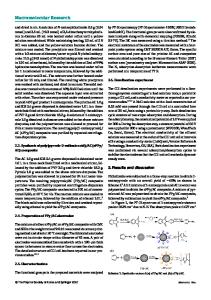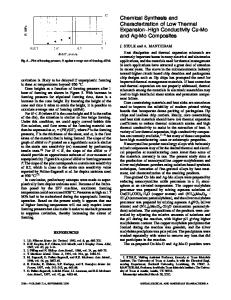Composites of polypyrrole and carbon black: Part III. Chemical synthesis and characterization
- PDF / 1,422,677 Bytes
- 12 Pages / 576 x 792 pts Page_size
- 107 Downloads / 297 Views
Krishnan Rajeshwara) Department of Chemistry and Biochemistry, The University of Texas at Arlington, Arlington, Texas 76019-0065
R. G. Pethe, R. C. Hyer, and S. C. Sharma Department of Physics, The University of Texas at Arlington, Arlington, Texas 76019-0065 (Received 20 January 1995; accepted 3 April 1995)
A new class of molecular composites of carbon black and an electronically conducting polymer, namely polypyrrole, has been synthesized by chemically polymerizing pyrrole in an aqueous dispersion of carbon black. The carbon black content of these composites can be varied from —5% to —85% (by weight). The surface area and density of these composites were compared to corresponding mixtures of carbon black and polypyrrole. The influence of carbon black on the efficiency of polymerization of pyrrole is described. The effect of carbon black content on the electronic conductivity of the composite has been mapped, and compared with the corresponding behavior of a mixture of carbon black and polyvinylchloride. The influence of the parent black characteristics (porosity, void volume, surface area) on the electronic conductivity of the resultant composite has been probed by comparing the behavior of composites derived from six commercial and experimental blacks. The temperature dependence of the composites has been studied as a function of the carbon black content. Filially, the application of these new materials is an environmental remediation scenario is demonstrated for Cr(vi) as a model pollutant.
I. INTRODUCTION 1>2
we described In companion papers in this series, composites of polypyrrole and carbon black that were electrosynthesized from an aqueous medium containing the monomer (pyrrole) and the carbon black dispersion. Anodic polymerization of pyrrole was induced in this medium either by applying a constant current (galvanostatic mode) or a constant potential (potentiostatic mode). Alternatively, the anode potential may be swept, and the polypyrrole film grown via a potentiodynamic method. In all the cases, the carbon black particles, because of their negative surface change,3 migrate toward the (positively charged) anode and are then embedded within the growing polypyrrole matrix. The result is a threedimensional assemblage of the carbon black particles dispersed in a continuous medium of polypyrrole. The electrosynthesis approach offers a convenient means of immobilizing the composite coating onto a suitable electrode support, and this configuration is suited to a number of potential applications including sensors, electrocatalysis, charge-storage devices (e.g., supercapacitors), fuel cells, etc. However, the electrosynthesis route does suffer from two handicaps that are associa)
Address correspondence to this author. J. Mater. Res., Vol. 10, No. 7, Jul 1995 http://journals.cambridge.org
Downloaded: 13 Mar 2015
ated with the characterization of these new materials: (a) Unless very large electrode supports are used, the quantity of material generated is rather small with attendant difficulties in morpholog
Data Loading...











